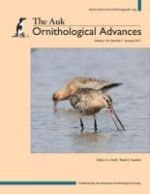Juvenile prospecting, or exploratory behavior for gleaning information about areas or events, can have profound effects on the selection of future breeding habitat, particularly for birds with high site fidelity whose initial choice of breeding habitat could represent a lifetime investment in fitness. We present data from a 10-yr study of Piping Plovers (Charadrius melodus) on the Missouri River, USA, to determine whether postfledging, hatch-year (HY) prospecting movements inform second-year (SY) nest site choices. First, we compared the home ranges of HY and adult (after-hatch-year; AHY) plovers to investigate whether differences in habitat use existed between HY and AHY plovers. Second, we evaluated the effects of prospecting, nest density, reproductive success, and nesting and foraging habitat availability on SY plover nest site selection. Lastly, we evaluated the potential reproductive benefits of nesting in prospected areas by comparing the nest success and fledging success of SY plovers that nested within their HY prospecting range with the success of those that nested in presumably unexplored areas. Plover home ranges varied across ages and among years. Both HY and AHY plover home ranges were smaller when the proportion of foraging habitat in the home range was relatively high, compared with nonforaging habitat. Second-year plovers selected sandbars that they had prospected as HY birds more often than would have been expected if nest site selection were random. Second-year plovers also selected sandbars on which other plovers experienced higher average nesting success than on random nesting locations, but we found no evidence that individual SY birds that nested on prospected sandbars had higher reproductive success than individuals that nested in unexplored areas. Coupled with high adult site fidelity, affinity of plovers for sandbars where they experience relatively high average reproductive success could lead to long-term gains in fitness.
How to translate text using browser tools
16 November 2016
Hatch-year Piping Plover ( Charadrius melodus) prospecting and habitat quality influence second-year nest site selection
Kayla L. Davis,
Kelsey L. Schoenemann,
Daniel H. Catlin,
Kelsi L. Hunt,
Meryl J. Friedrich,
Shannon J. Ritter,
James D. Fraser,
Sarah M. Karpanty

The Auk
Vol. 134 • No. 1
January 2017
Vol. 134 • No. 1
January 2017
Charadrius melodus
habitat selection
home range
natal dispersal
Piping Plover
prospecting




